Keywords
|
| Wi-Fi, WiMAX, DSL, MIMO, IEEE |
I. INTRODUCTION
|
| A. WiMAX overview: |
| Worldwide Interoperability for Microwave Access, which is known as WiMAX , is currently one of the advanced technologies in wireless domain. The Institute of Electrical and Electronics Engineers (IEEE) 802 committee has published a set of standards that define WiMAX. WiMAX works based on a technology called Orthogonal Frequency Division Multiplexing (OFDM). This method is very effective means of transferring data if carriers of width of 5MHz or greater are used. Carrier width less than 5MHZ and current CDMA which is based on 3G systems are comparable to OFDM. WiMAX is a wireless technology which is capable of providing high throughput broadband connections for even very long distance. This technology can be used for a number of applications, including “last mile” broadband connections. WiMAX is capable of providing wireless metropolitan area network (MAN) connectivity, which speeds up to 70 Mbps and the WiMAX base station on the average can cover a distance of 5 to 10 km. Table 1 that is given below explains the applications and overview of fixed outdoor and fixed indoor. |
| B. WiMAX Infrastructure: |
| Generally, WiMAX consists of two parts: |
| 1. WiMax Base Station: |
| The contents of WiMAX base station are indoor electronics and a WiMAX tower. The base station coverage range is theoretically up to 50 Kilometres, but practically it is limited to 10 Kilometres. All the nodes that are in the coverage can access the internet. |
| 2. WiMAX receiver: |
| This receiver could be a standalone box or it could be a PC card that sits in a laptop or computer. Access to this base station is similar to that of accessing a Wireless Access Point in a Wi-Fi network, but WiMAX has wider coverage area compared to that of Wi-Fi. |
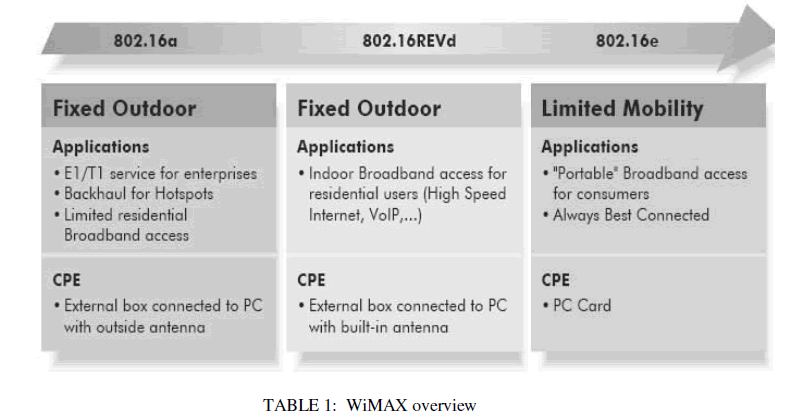 |
| In Table 1 applications and characteristics of different IEEE standards are compared. |
| 3. WiMax Protocol: |
| An 802.16 wireless service provides a communications path between a subscriber site and a core network such as the public telephone network and the Internet. This technology provides the missing link for the "last mile" connection in MANs where DSL, Cable and other methods are either unavailable or might be too expensive. |
 |
| In table 2 we can see different parameters like frequency band and range for technologies such as WiMAX, WLAN, and Bluetooth. |
II. BACKGROUND
|
| Interest in broadband wireless access (BWA) has been growing due to increased user mobility and the need for data access at all times. IEEE 802.16e based WiMAX networks promise the best available quality of experience for mobile data service users. |
| Fan Wang conducted experiments to analysing the WiMAX performance using multiple transmitter and multiple receiver antennas and analysed the results via system simulations. For study of downlink two kinds of technologies are studied i) open loop and ii) closed loop. In open loop method the base station has no knowledge of channel and uses mobile mode selection feedback to switch between single data stream STBC and multi-stream spatial multiplexing MIMO (SM-MIMO). In closed loop the base station has explicit knowledge of downlink channel and transmits using adaptive beam forming. In that proposed theory he compares the WiMAX downlink system performance using open loop and closed loop MIMO technologies with various frequencies reuse factors and different data traffic model. |
| Kah Heng Ng has developed an advanced retracing model which is site-specific image based, enables the analysis of multi element outdoor propagation to be performed in urban environments. To improve the run time efficiency, optimization techniques such as pre-processing the environment database using object partitioning and visibility deterioration. Wideband and multiple-input-multiple-output (MIMO) site-specific predictions (including derived parameters such as theoretic capacity and eigen structure) are compared with outdoor site-specific measurements at 1.92 GHz. Results indicate that the ray-tracing model successfully predicts key channel parameters (including MIMO channel structure) and thus enable the accurate prediction of packet-error rate (PER) and service coverage for emerging MIMO-OFDM networks such as 802.11n and 802.16e. |
III. SCOPE OF THE RESEARCH
|
| The wimax model 802.16 is pre-defined in the Matlab with 1*1 and 2*1 configurations, the performance analysis of the present models was done and then the latter two MIMO configurations i.e. 2*2 and 4*4 were designed and then the performance of these two configurations were analysed and then an comparative study was done and the best design is selected according to the requirements. |
IV. ANTENNA CONFIGURATION AND DESIGNING
|
| The following antenna configurations were designed tested and the following conclusion was made comparing the results. |
`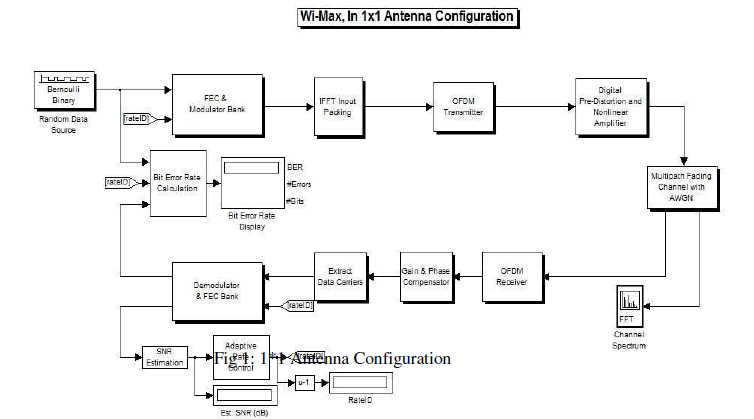 |
| In the fig 1, the wimax model 802.16 is pre-defined in the Matlab with 1*1 is shown. |
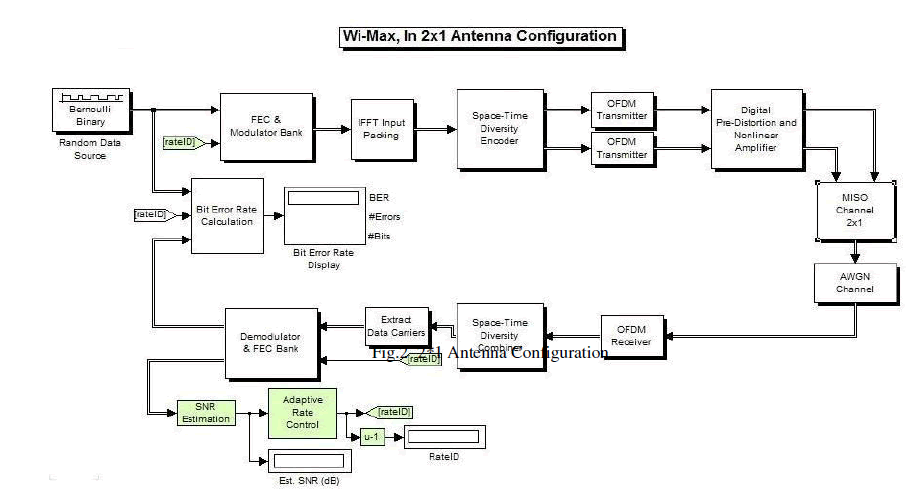 |
| In the fig 2, the wimax model 802.16 is pre-defined in the Matlab with 2*1 is shown. |
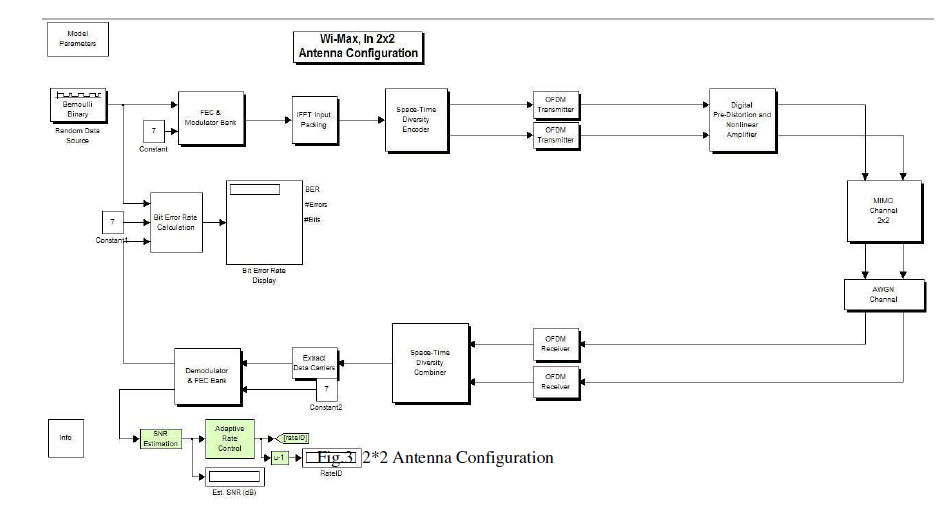 |
| In the fig 3, the wimax model 802.16 is pre-defined in the Matlab with 2*2 is shown. |
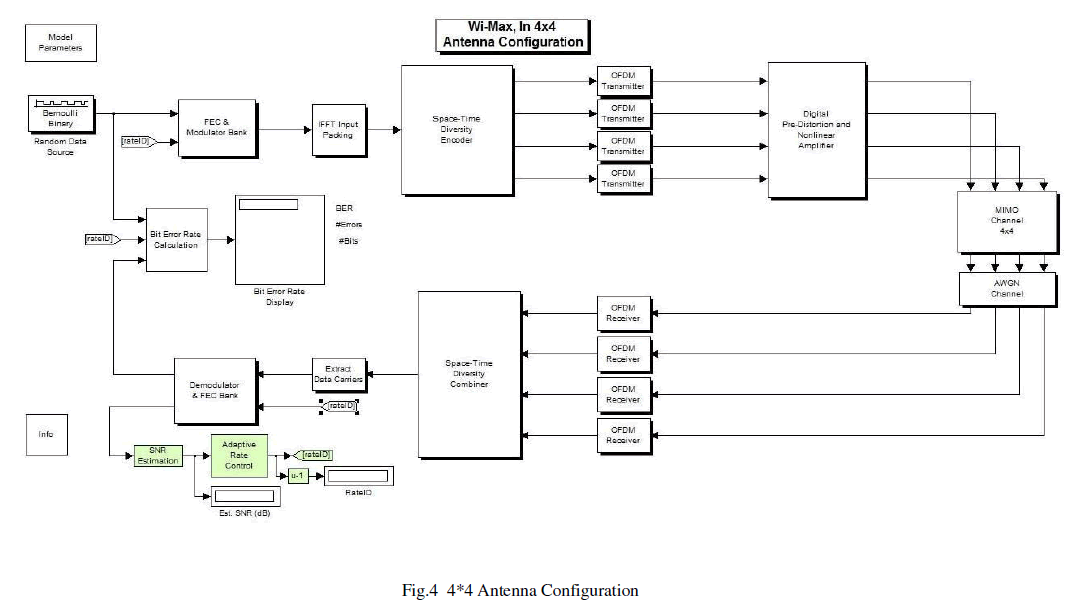 |
| In the basic wimax model a Bernoulli generator is used to generate data randomly based on Bernoulli equation and then it is passes through an FEC block which corrects the forward error with the help of a modulator bank, since OFDM technology is used in the wimax hence it is then passes through the IFFT block as it is then converted to time domain initially using this block and then encoding is done with the space time diversity encoder. |
| After it is encoded then the data is passed through the OFDM transmitter followed by the respective channel. The number of transmitter used is dependent on the antenna configuration which is put to use. Then it is passed through the respective channel i.e. AWGN or Rayleigh channel or both. |
| Then at the receiver side we obtain the received signal via OFDM receiver and, OFDM multiplexing is used in wimax because of its key features such as orthogonality, then the received signal is decoded via space time diversity combiner from here only we obtain the BER comparing the result with the input sequence or signal, then the FEC is corrects the incoming data with the help of its modulator bank. |
| The rate id is selected considering the SNR, the rate id is automatically changed as wimax has adaptive modulation coding (AMC), and the modulation technique is chosen accordingly to the SNR required. The BER is determined by the separate unit which calculates the BER comparing the output and the input signal. We have designed the wimax system with different antenna configuration using MIMO concept and checked for the BER rate which we obtain from each of the configuration. A certain deductions were made from the results obtained that the BER rate decreases as the antenna configuration increases. |
| Hence we see that for the 4*4 antenna configuration, it has the least BER and the 1*1 antenna configuration has the maximum BER the reason behind the above condition is that the higher the antenna configuration more is the data redundancy as more number of antenna transmit the same data and the probability for the receiver to receive the data correctly increases hence BER decreases. |
| The wimax model 802.16 is pre-defined in the Matlab with 1*1(Fig.1) and 2*1(Fig.2) configurations, the performance analysis of the present models was done and then the latter two MIMO configurations i.e. 2*2(Fig. 3) and 4*4(Fig. 4) were designed and then the performance of these two configurations were analysed and then an comparative study was done and the following deductions were made and justified. |
V. RESULTS AND DISCUSSION`
|
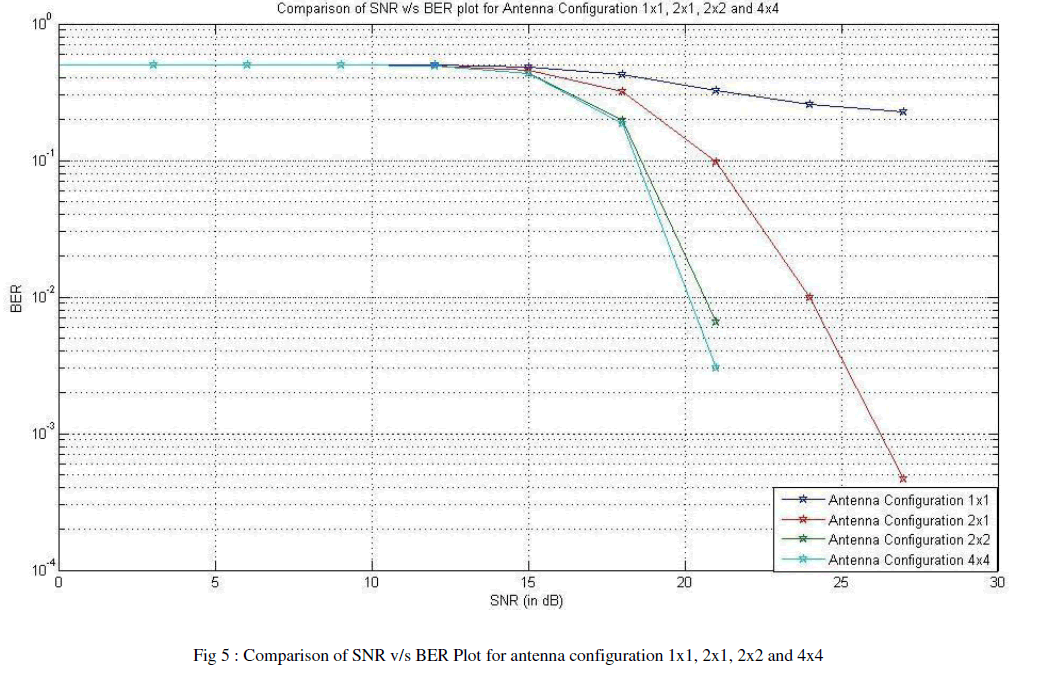 |
| Here we vary the SNR in all the antenna configurations 1x1, 2x1, 2x2 and 4x4 and plot the graph(Fig. 5) for SNR v/s BER and observe that as we increase the antenna configurations we get better performance of BER for desired SNR. |
| As we increase the antenna configuration from 1x1 to 2x1 the redundancy of signal increases and we obtain a better result. Further when we increase it to 2x2 the redundancy increases more and we obtain much better result from 1x1 and 2x1. |
| And when further increasing the antenna configuration to 4x4 we get the best result. Further if we increase the antenna configuration to higher configurations we will get better results but the complexity will also increase |
References
|
- J. B. Andersen, “Array gain and capacity for known random channels with multiple element arrays at both ends,” IEEE J. Select. AreasCommun., vol. 18, no. 11, pp. 2172–2178, Nov. 2000.
- D. Shiu P. J. Smith D. Gesbert, M. Shafi and A. Nayguib, “From theory to practice: An overview of MIMO space–time coded wireless systems,”IEEE J. Select. Areas Commun.,vol. 21, no. 3, pp. 281–302, Apr. 2003.
- Z. Wang and G. B. Giannakis, “A simple and general parametrization quantifying performance in fading channels,” IEEE Trans. Commun., vol.51, no. 8, pp. 1389– 1398, Aug. 2003.
- Alamouti, S. M. „„A Simple Transmit Diversity Technique for Wireless Communications,âÃâ¬ÃŸÃ¢Ãâ¬ÃŸIEEE Journal Select. Areas commun., Vol. 16, No.8, October 1998, pp. 1451–1458.
- Tarokh, V.,H. Jafarkhani, and A. R. Calderbank, „„Space-Time Block Coding for Wireless: Performance Results,âÃâ¬ÃŸÃ¢Ãâ¬ÃŸ IEEE J. Select. AreasCommun., Vol. 17, No. 3, March 1999,pp. 451–460.
- Tarokh, V.,H. Jafarkhani, and A. R. Calderbank, „„Space-Time Block Codes From Orthogonal Designs,âÃâ¬ÃŸÃ¢Ãâ¬ÃŸ IEEE Trans. Inform. Theory, Vol. 45,No. 5, July 1999, pp. 1456–1467.
- L. Liu, J. Tong, and Li Ping, “Analysis and optimization of CDMA systems with chip-level interleavers,” IEEE J. Select.Areas Commun., vol. 24,no. 1, pp. 141-150, Jan.2006
- Fan Wang , Ghosh, A. ; Sankaran, C. ; Benes, S. Vehicular Technology Conference, 2007. VTC2007-Spring. IEEE 65th
- Kah Heng Ng;Tameh, E.K. ; Doufexi, A. ; Hunukumbure, M. , Vehicular Technology, IEEE Transactions on (Volume:56 , Issue: 3 ), May 2007
|